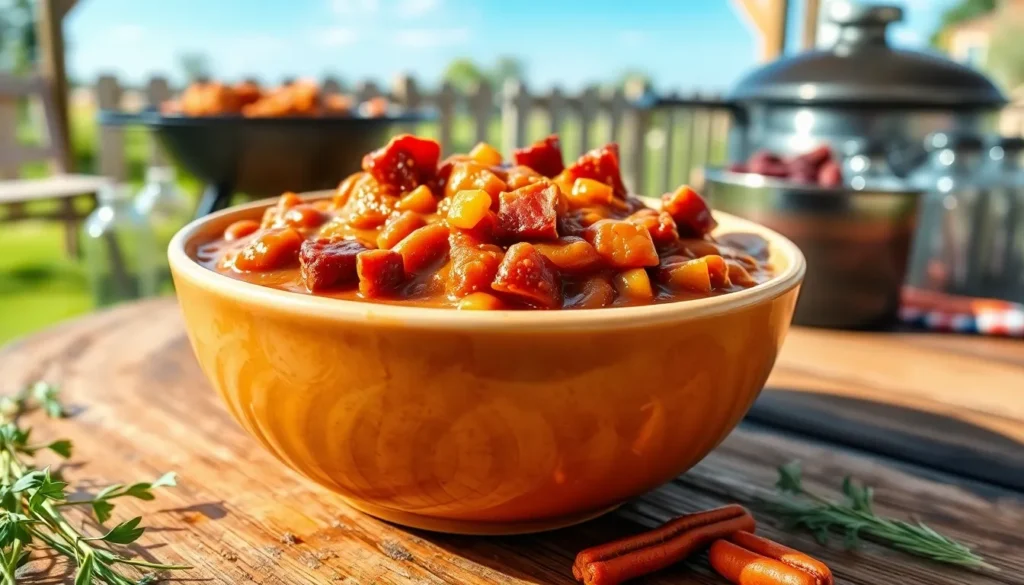Nothing beats the smoky sweetness of homemade barbecue baked beans at your next cookout. We’ve perfected this crowd-pleasing recipe that transforms ordinary beans into a rich, flavorful side dish that’ll have everyone asking for seconds. These aren’t your typical canned beans – we’re talking about a from-scratch masterpiece that combines tender navy beans with a bold barbecue sauce that’s perfectly balanced between sweet and tangy.
The magic happens when we slow-bake these beans with crispy bacon, caramelized onions, and our signature blend of molasses, brown sugar, and spices. The result? Creamy beans swimming in a thick, glossy sauce that pairs beautifully with grilled meats, cornbread, or coleslaw.
Whether you’re hosting a backyard barbecue or planning a potluck contribution, these barbecue baked beans deliver restaurant-quality flavor with surprisingly simple ingredients. We’ll show you how to achieve that perfect consistency and depth of flavor that makes this recipe a guaranteed hit.
Ingredients
We need quality ingredients to build the complex layers of flavor that make these barbecue baked beans exceptional. Our carefully selected components work together to create the perfect balance of smokiness, sweetness, and rich depth.
For the Beans
- 1 pound dried navy beans, soaked overnight and drained
- 6 strips thick-cut bacon, chopped into ½-inch pieces
- 1 large yellow onion, diced
- 3 cloves garlic, minced
- 4 cups low-sodium chicken broth
- 2 cups water
- 1 bay leaf
For the Barbecue Sauce
- ⅓ cup molasses
- ¼ cup packed dark brown sugar
- ¼ cup apple cider vinegar
- 3 tablespoons tomato paste
- 2 tablespoons Worcestershire sauce
- 1 tablespoon Dijon mustard
- 1 teaspoon smoked paprika
- ½ teaspoon ground cumin
- ½ teaspoon chili powder
- ¼ teaspoon cayenne pepper
- 1 teaspoon kosher salt
- ½ teaspoon black pepper
Optional Toppings
- 2 tablespoons fresh chives, chopped
- 1 tablespoon crispy bacon bits, reserved from cooking
- ¼ teaspoon smoked paprika for dusting
Equipment Needed
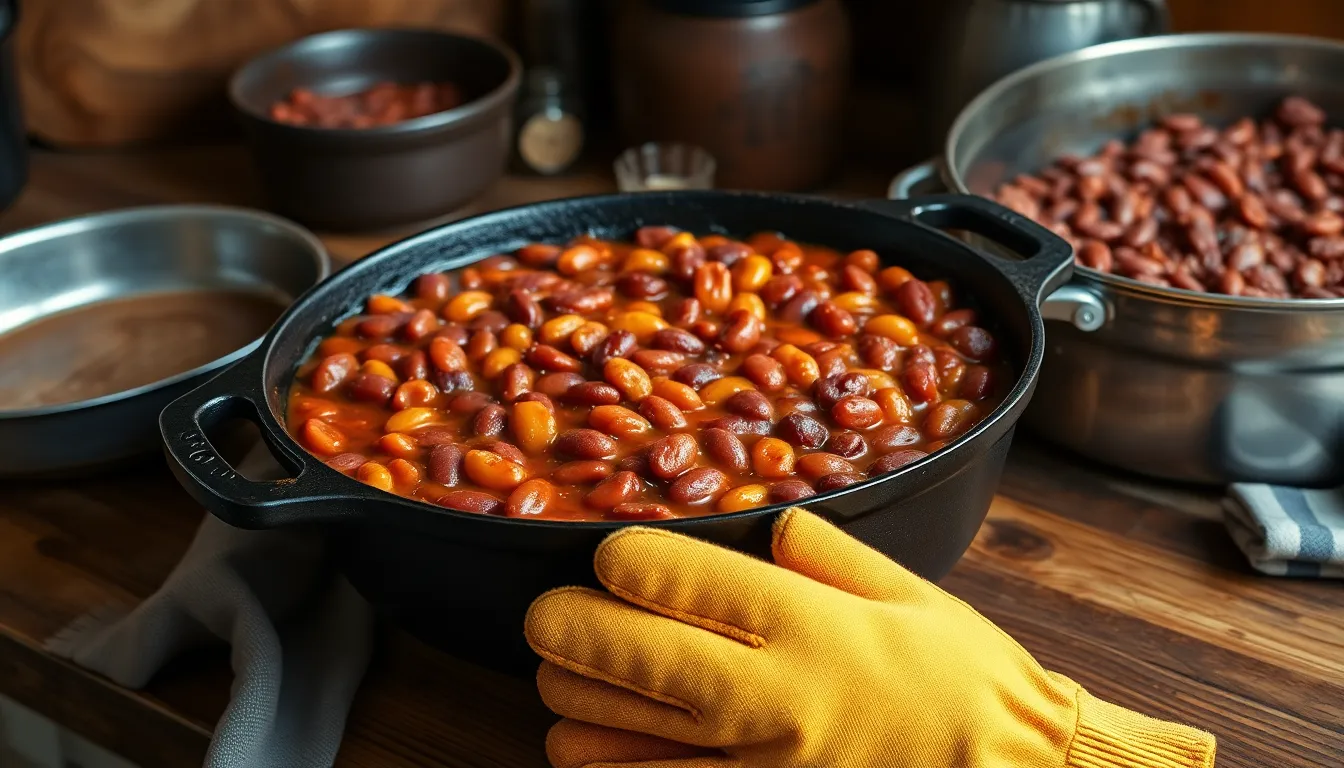
Creating perfect barbecue baked beans requires the right tools to achieve that signature smoky flavor and creamy texture. We recommend gathering essential equipment before starting this recipe to ensure smooth preparation and optimal results.
Our primary cooking vessel should be a large cast iron skillet or Dutch oven that can handle both stovetop searing and oven baking. Cast iron provides superior heat retention and adds subtle smoky notes that enhance the overall flavor profile. A 6-quart Dutch oven works perfectly for this recipe’s quantities.
For soaking our dried navy beans overnight, we need a large mixing bowl that accommodates the beans plus several inches of water for proper expansion. The beans will nearly double in size during soaking.
A deep baking dish measuring approximately 15×10 inches serves as an excellent alternative to cast iron when feeding larger crowds. This size provides adequate surface area for even heat distribution while preventing overflow during the long baking process.
Basic kitchen tools complete our equipment list. We use a spider strainer or slotted spoon for transferring beans between vessels. Sharp knives handle onion dicing and bacon chopping with precision. Measuring cups and spoons ensure accurate ingredient ratios that balance sweetness and smokiness.
Heat source flexibility allows us to customize cooking methods. Traditional ovens work beautifully for classic baked beans. Smokers or pellet grills like the Traeger Ironwood XL elevate the dish with authentic barbecue flavor through controlled smoke exposure.
| Equipment Category | Essential Items | Optional Upgrades |
|---|---|---|
| Cooking Vessels | Cast iron skillet, Dutch oven | Deep baking dish, aluminum pan |
| Heat Sources | Standard oven | Pellet grill, smoker |
| Basic Tools | Large bowl, measuring tools, knives | Spider strainer, heat-resistant gloves |
We always keep heat-resistant gloves nearby when handling hot cast iron or transferring dishes from high-temperature ovens. These safety tools prevent burns while maintaining cooking momentum during critical timing phases.
Prep Work

Getting ahead on the preparation makes our barbecue baked beans recipe much smoother. We’ll focus on two key steps that set the foundation for incredible flavor.
Soaking the Beans
We start by soaking our 1 pound of dried navy beans overnight in cold water in the refrigerator. This process softens the beans and significantly reduces our cooking time. Soaking the beans in salted water works best since salt doesn’t toughen the beans as many people believe. Instead, salt actually helps create creamier beans with better texture.
We recommend using enough water to cover the beans by at least 2 inches since they’ll expand as they absorb moisture. The soaking liquid becomes valuable for cooking, so we save it rather than discarding it. This bean-infused water adds extra flavor and nutrients to our final dish.
Preparing the Vegetables
We dice our large yellow onion and mince 3 cloves of garlic while the beans soak. Sharp, uniform cuts ensure even cooking and better flavor distribution throughout our barbecue sauce.
Our thick-cut bacon needs to be chopped into bite-sized pieces before cooking. We cut the bacon while it’s still cold from the refrigerator since this makes cleaner cuts. The bacon pieces should be roughly the same size as our diced onions for consistent cooking.
Having all vegetables prepped and ready allows us to focus on the cooking process without interruption. We keep the diced onions and minced garlic in separate bowls until we’re ready to add them to the pot.
Instructions
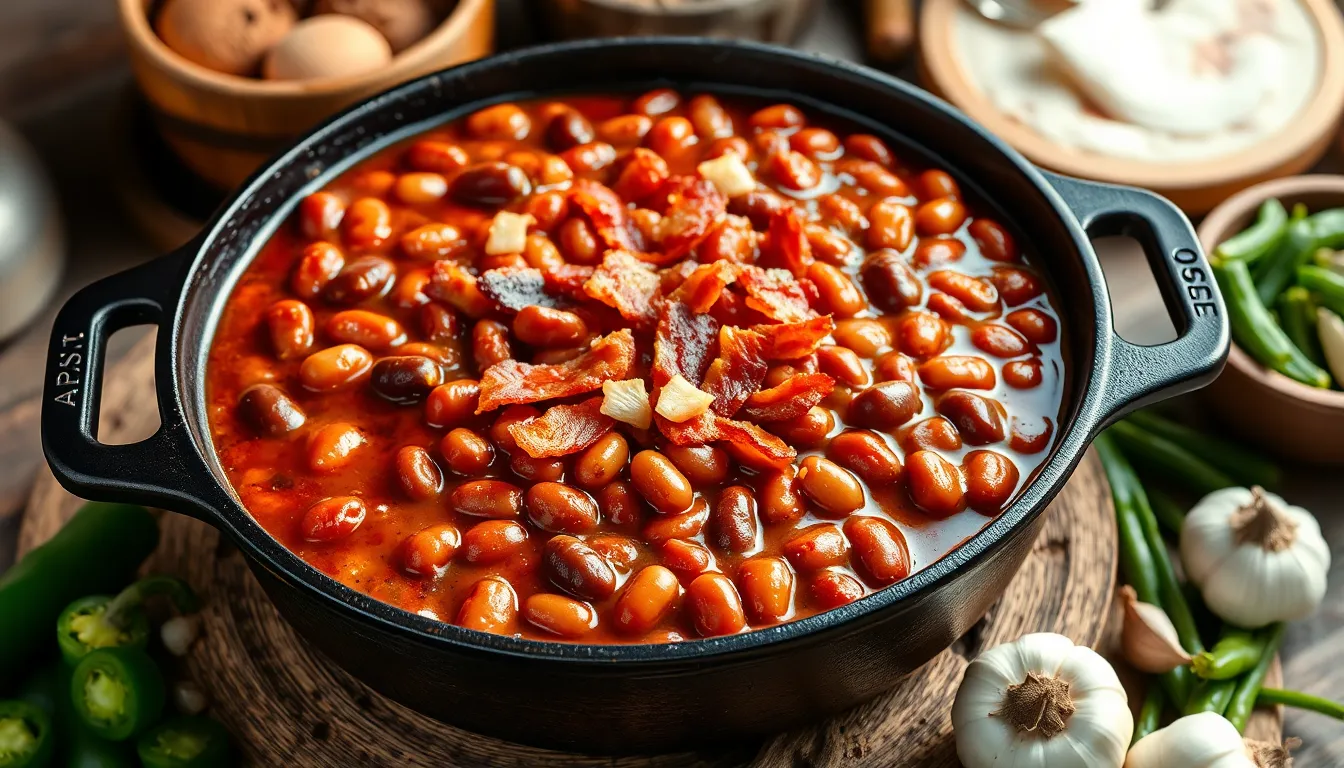
Now we’ll transform our prepped ingredients into those signature barbecue baked beans that elevate any cookout. These step-by-step instructions guide you through creating the perfect balance of smoky and sweet flavors.
Making the Barbecue Sauce
We begin by combining all our barbecue sauce ingredients in a large mixing bowl. Pour in 1 cup of Texas Style BBQ sauce as our flavor base.
Add 1 cup of Dr. Pepper for that distinctive sweetness and carbonated tang. Root beer or regular cola work as excellent substitutes if Dr. Pepper isn’t available.
Whisk in ¼ cup apple cider vinegar to brighten the sauce with acidity. Follow with 2 tablespoons molasses for deep caramel notes.
Stir in 2 tablespoons Dijon mustard and 2 tablespoons tomato paste for complexity and body. Season with 1 tablespoon salt and 2 teaspoons black pepper.
Mix everything thoroughly until the sauce appears smooth and well-incorporated. Set aside while we prepare the bean mixture.
Assembling the Beans
Heat your large cast iron skillet or Dutch oven over medium-high heat. Add 1 pound of diced bacon and cook until the pieces become crispy but still retain some softness.
Drain most of the bacon grease while leaving about 1 tablespoon in the skillet for flavor. This rendered fat will enhance every element of our dish.
Add your diced yellow onion and seeded jalapeños to the skillet with the bacon. Cook until the vegetables soften and the bacon reaches perfect crispiness.
Stir in 4 minced garlic cloves and cook for 30 seconds until fragrant. The aromatics should fill your kitchen with their enticing scent.
Add all 4 cans of drained great northern beans and 1 can of black beans to the skillet. Sprinkle in 1 cup of brown sugar for that essential sweetness.
Pour our prepared barbecue sauce over the bean mixture. Stir everything together until each bean gets coated with the rich sauce.
Baking Process
Preheat your oven to 275°F while the bean mixture rests in the skillet. This moderate temperature ensures slow cooking without burning the sugars.
Transfer the entire skillet into the preheated oven if using an oven-safe pan. Otherwise move the mixture to your prepared baking dish.
Bake for approximately 1 hour while stirring every 20 minutes to prevent sticking. Watch as the sauce reduces and thickens around the beans.
The bacon fat renders throughout the cooking process while integrating all flavors deeply. Your beans are ready when the sauce appears glossy and clings to each bean.
Remove from oven when the consistency reaches your desired thickness. The finished beans should hold together without appearing dry or watery.
Cooking Tips and Techniques

Mastering the art of barbecue baked beans requires understanding key techniques that separate exceptional beans from ordinary ones. We’ll share our proven methods for achieving restaurant-quality results every time.
Achieving the Perfect Consistency
The sauce consistency makes or breaks barbecue baked beans. We aim for a thickness similar to pancake syrup or a rich glaze that coats each bean without appearing watery or dry.
Temperature Control
Maintain your oven or smoker between 275°F to 325°F for optimal results. This temperature range allows beans to soften thoroughly while the sauce reduces and thickens naturally through slow evaporation.
Timing and Technique
Bake beans low and slow for 1 to 4 hours depending on your desired consistency. Cover the dish during the first half of cooking to prevent moisture loss. Remove the cover during the final hour to allow surface caramelization and sauce thickening.
Monitoring and Stirring
Check beans every 30 minutes and stir gently to distribute heat evenly. This prevents sticking or burning while ensuring uniform texture throughout the dish. The sauce should cling to beans without pooling at the bottom.
Visual Cues
Look for a glossy finish where sugar and molasses caramelize slightly. Properly cooked beans hold their shape while feeling tender when pressed with a fork. The sauce should coat a spoon and fall in a steady ribbon when lifted.
Flavor Adjustments
Creating the perfect flavor balance requires understanding how different ingredients interact during the cooking process. We recommend tasting and adjusting seasonings throughout the cooking time.
Sweetness Balance
Adjust sweetness levels using brown sugar, honey, or molasses according to your preference. Add these ingredients gradually during the final hour of cooking to prevent burning. Different molasses varieties provide varying intensity levels.
Acidity and Tang
Balance sweet elements with apple cider vinegar or Dijon mustard for brightness. These acidic components cut through richness while improving overall flavor complexity. Start with small amounts and build gradually.
Heat and Spice
Introduce spice through barbecue rubs, hot sauce, or fresh jalapeños. Smoked paprika adds depth without overwhelming heat. Cayenne pepper provides clean heat that builds gradually.
Smokiness Enhancement
Use smoked bacon or add smoked paprika for authentic barbecue flavor. Cook bacon slowly to render fat without crisping for maximum flavor extraction. The rendered fat becomes part of your sauce base.
Bean Variety Considerations
Different bean types affect both texture and flavor absorption. Navy beans provide creamy texture while great northern beans hold their shape well. Pinto and kidney beans offer earthier flavors that complement bold barbecue sauces.
Make-Ahead Instructions
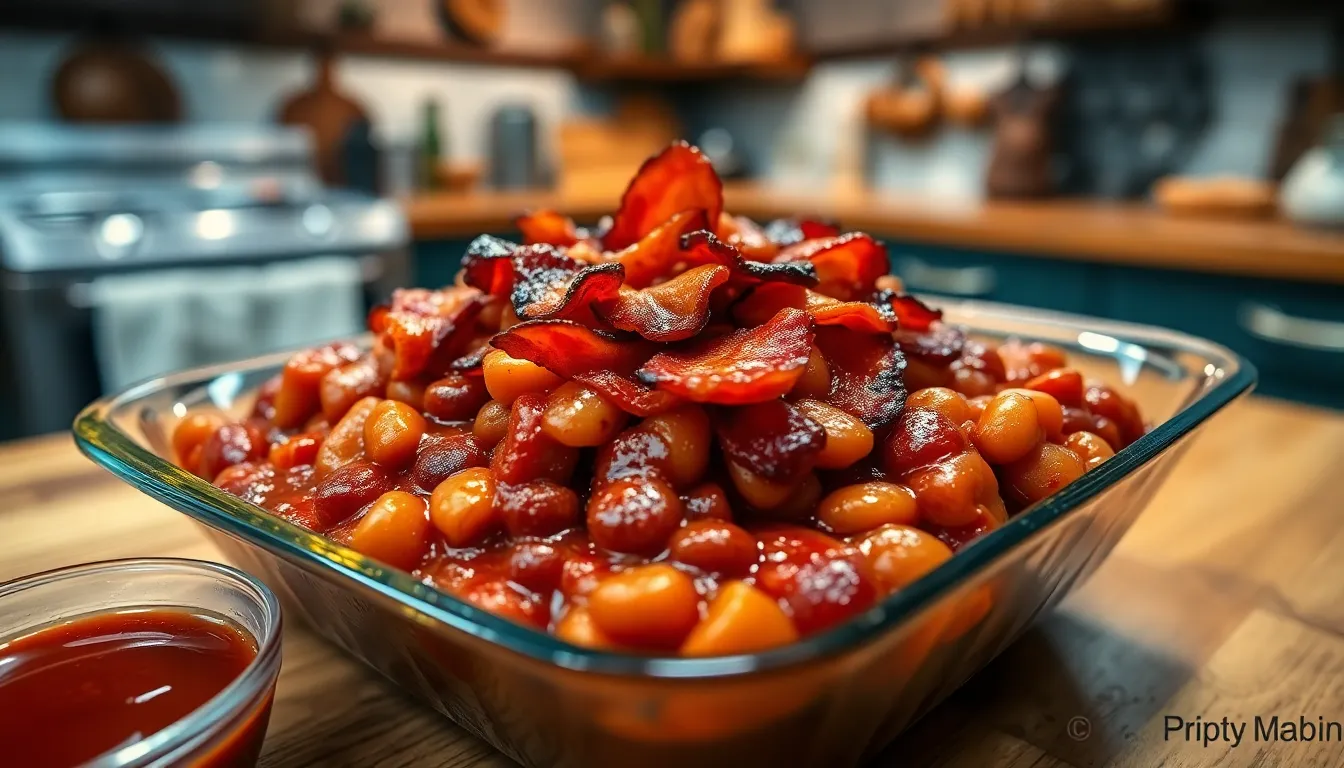
We love preparing barbecue baked beans ahead of time because they actually taste better after the flavors meld together overnight. Our make-ahead approach transforms these beans into an even more flavorful dish while eliminating stress on cooking day.
Freezer Method
We recommend assembling all ingredients except the crispy bacon topping for optimal freezer storage. Our favorite technique involves combining the soaked beans, sautéed vegetables, ground beef (if using), barbecue sauce, and seasonings in a large freezer bag. We squeeze out all air before sealing and laying the bag flat in the freezer for space-efficient storage.
When we’re ready to cook, we thaw the mixture completely in the refrigerator overnight. We transfer everything to our greased baking dish and proceed with the normal baking instructions at 325°F. Adding fresh cooked bacon on top before baking gives us that perfect smoky crunch we crave.
Partial Preparation Strategy
We often prepare our barbecue baked beans the night before serving by combining all ingredients in our baking dish. Our technique involves covering the assembled dish tightly with plastic wrap and refrigerating overnight. This method allows the brown sugar and barbecue sauce to penetrate the beans more deeply.
We bring the chilled dish to room temperature for 30 minutes before baking to ensure even cooking. Adding 15 to 20 minutes to our normal cooking time compensates for the cold start temperature.
Fully Cooked Storage
We frequently bake our beans completely and store them for later reheating. Our cooled beans keep beautifully in airtight containers in the refrigerator for up to four days. We portion them into smaller containers for easier reheating and serving flexibility.
Reheating requires gentle warming in a 300°F oven covered with foil to prevent drying out. We stir occasionally and add a splash of barbecue sauce or chicken broth if the mixture appears too thick. Our slow cooker works perfectly for keeping fully cooked beans warm during potlucks and gatherings.
Potluck Preparation Tips
We always prepare extra barbecue sauce separately when making beans ahead for potlucks. Our experience shows that beans can absorb moisture during transport and reheating. Having additional sauce on hand allows us to adjust consistency and refresh flavors before serving.
We recommend thick-cut or peppered bacon for make-ahead preparations because it maintains better texture after freezing and reheating. Our testing shows that regular bacon can become soggy when prepared too far in advance.
Storage and Reheating

We know that properly storing and reheating our barbecue baked beans ensures they maintain their rich flavor and perfect texture for future meals. Our baked beans actually improve in flavor after resting as the ingredients continue to meld together making them an excellent make-ahead dish.
Proper Storage Methods
Store leftover barbecue baked beans in an airtight container in the refrigerator where they will stay fresh for up to 5-7 days. We recommend transferring the beans to shallow containers for faster cooling and more efficient storage space. Glass containers work particularly well as they don’t absorb flavors and make reheating easier.
For longer storage we can freeze our baked beans for up to 3 months in freezer-safe containers or heavy-duty freezer bags. Leave about an inch of headspace in containers to allow for expansion during freezing. Label containers with the date to track freshness and ensure we use the oldest batches first.
Reheating Techniques
Oven Method: Thaw frozen beans overnight in the refrigerator then transfer to a covered baking dish. Reheat at 325°F for 20-30 minutes until the beans are hot and bubbly throughout. We find this method best preserves the original texture and prevents the sauce from separating.
Stovetop Method: Place beans in a heavy-bottomed saucepan over medium heat and warm for 5-10 minutes stirring occasionally. Add a splash of water or broth if the sauce appears too thick during reheating. This method gives us the most control over the final consistency.
Microwave Method: Cover the beans with a paper towel or microwave-safe lid to prevent splattering then heat in 1-minute intervals stirring between each interval until warmed through. We use this quick method when reheating single portions.
Maintaining Quality During Reheating
Covering our beans during reheating helps retain moisture and prevents the top layer from drying out. We always check that the internal temperature reaches 165°F for food safety. Adding a small amount of barbecue sauce or broth during reheating refreshes the flavors and restores the ideal consistency if the beans have thickened too much in storage.
Serving Suggestions
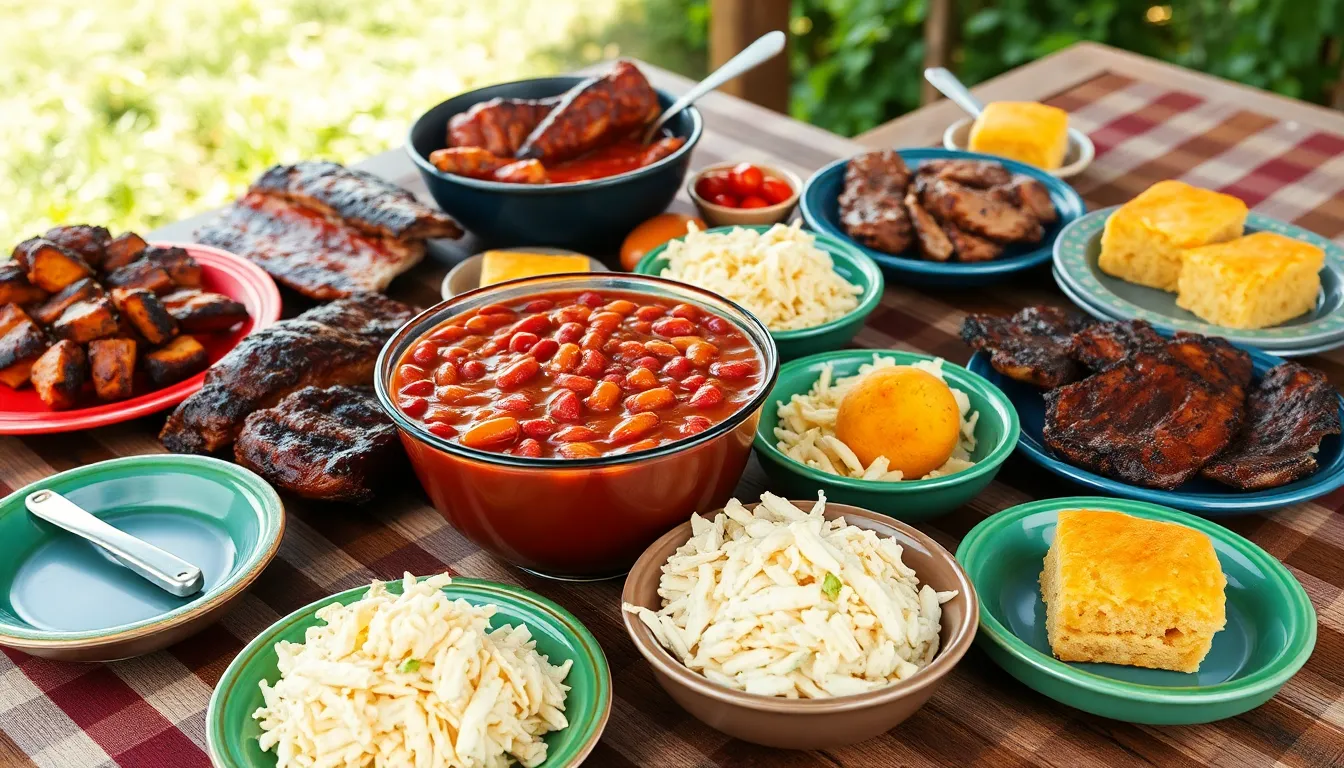
Our barbecue baked beans shine brightest when paired with the right companions at your next gathering. We recommend serving these smoky gems alongside grilled or smoked meats like tender ribs, juicy brisket, pulled pork, or perfectly charred chicken. These protein-packed mains create the ultimate barbecue experience when combined with our rich, syrupy beans.
Classic cookout fare becomes even more memorable with our baked beans on the side. Burgers and hot dogs benefit from the sweet and tangy contrast these beans provide. We love how the smoky barbecue sauce complements the grilled flavors of these American favorites.
Cornbread or crusty bread serves as the perfect vehicle for soaking up every drop of our savory sauce. The combination of warm bread and these hearty beans creates a satisfying comfort food experience that guests will remember long after the meal ends.
Fresh salads or crisp coleslaw help balance the richness of our bacon-enhanced beans. These lighter sides provide a refreshing contrast that cleanses the palate between bites of the sweet and smoky mixture. We find that acidic elements in salads particularly complement the deep flavors we’ve built into this dish.
Vegetarian dishes like grilled vegetables or seasoned tofu pair surprisingly well with our barbecue baked beans for a complete meal. The beans provide substantial protein and fiber that transforms lighter plant-based options into hearty, satisfying dinners.
Our recipe works beautifully for any barbecue or picnic-style meal where comfort food takes center stage. The warming qualities and perfect balance of sweet, tangy, and smoky flavors make these beans an ideal choice for outdoor gatherings, potluck dinners, and family celebrations where everyone expects that classic barbecue taste.
Recipe Variations
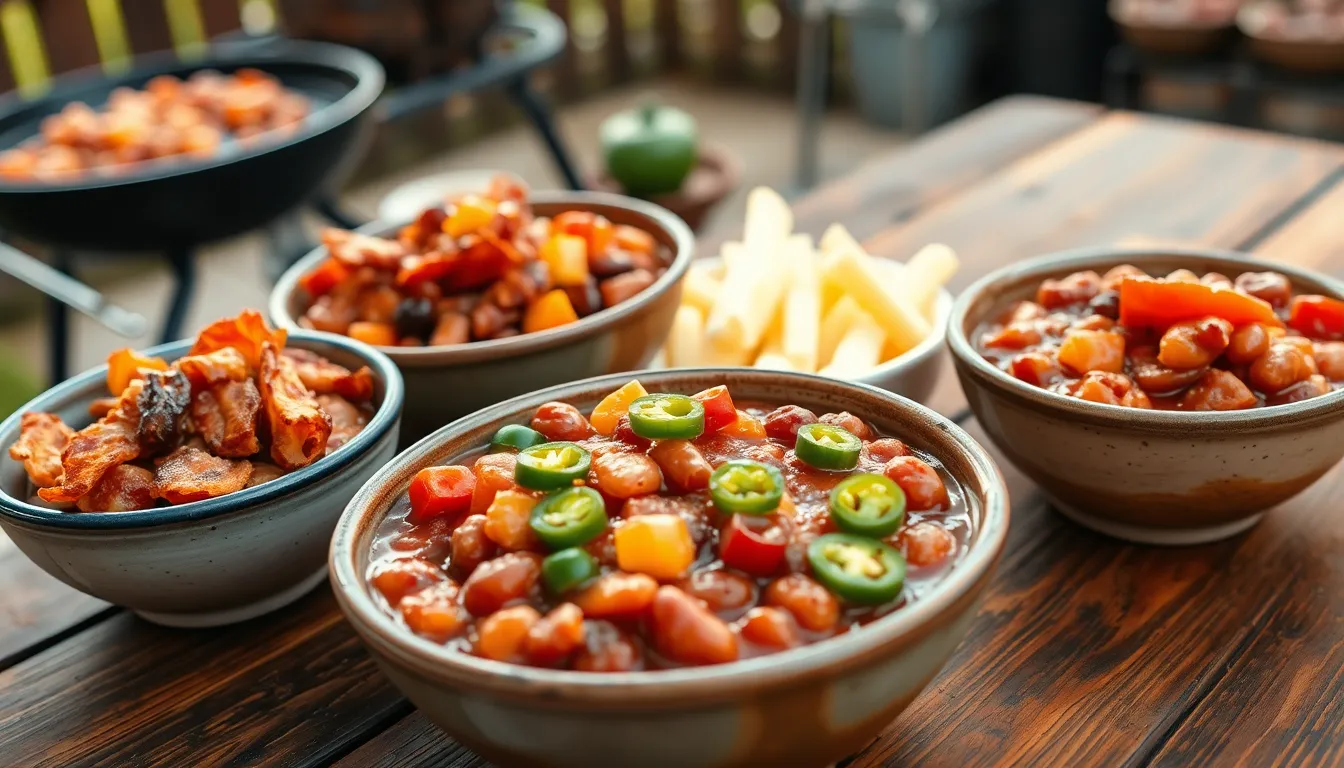
Our classic barbecue baked beans recipe serves as the perfect foundation for creative adaptations that suit different tastes and dietary preferences. These variations build upon the core techniques while introducing unique flavor profiles.
Smoky Bacon Version
We enhance our base recipe by incorporating thick-cut bacon to create deeper smoky richness. Cook 6-8 strips of bacon until crisp in our Dutch oven before removing and setting aside. The rendered bacon fat becomes our cooking medium for sautéing diced onions and bell peppers until caramelized. This technique infuses the vegetables with smoky flavor while building layers of complexity.
We fold the crispy bacon pieces back into our beans during the final hour of baking. The bacon fat continues rendering throughout the slow cooking process while the meat adds textural contrast to the creamy beans. Our barbecue sauce absorbs these smoky notes while the bacon maintains its satisfying bite.
Vegetarian Option
We transform our recipe into a plant-based version without sacrificing flavor depth or richness. Replace chicken broth with vegetable stock throughout the cooking process. Our sauce gains smoky complexity through smoked paprika and chipotle powder rather than bacon.
We incorporate 2 teaspoons of smoked paprika and 1 teaspoon of chipotle powder into our barbecue sauce mixture. These spices replicate the smokiness traditionally provided by pork products. Additional umami comes from doubling our Worcestershire sauce and adding 2 tablespoons of soy sauce.
The cooking method remains identical to our original recipe. We monitor the beans closely since vegetarian versions may require slightly longer baking times to achieve the same sauce consistency.
Spicy Kick Variation
We amplify heat levels by incorporating multiple chili elements throughout our cooking process. Start by adding 2-3 minced jalapeño peppers to the bacon and onion mixture during the sautéing stage. Our barbecue sauce receives additional fire through hot sauce and ground cayenne pepper.
We recommend increasing cayenne pepper to 1 teaspoon and adding 2 tablespoons of your favorite hot sauce to the barbecue mixture. Chipotle powder provides both heat and smokiness when we add 1-2 teaspoons depending on desired intensity.
Balance becomes crucial in our spicy version. We maintain the brown sugar and molasses quantities to counteract the heat while ensuring the beans remain approachable. The sweet and tangy elements create harmony with the spicy components rather than overwhelming them.
Conclusion
We’ve shared everything you need to transform simple navy beans into a show-stopping barbecue side dish that’ll have your guests asking for seconds. With proper preparation overnight soaking and our signature sauce blend you’ll achieve that perfect balance of smoky sweetness and rich flavor.
These barbecue baked beans aren’t just another side dish – they’re a conversation starter that elevates any cookout or family gathering. The make-ahead options and storage tips we’ve covered ensure you can enjoy this crowd-pleaser whenever the craving strikes.
Whether you stick to our classic recipe or experiment with the spicy or vegetarian variations we’ve outlined you’re guaranteed to create something special. Fire up that oven and get ready to serve the best barbecue baked beans your family and friends have ever tasted.
Frequently Asked Questions
What type of beans work best for barbecue baked beans?
Navy beans are ideal for barbecue baked beans because they have a creamy texture and absorb flavors well. However, you can also use pinto beans, kidney beans, or great northern beans. Each variety offers slightly different textures and flavors. Always use dried beans soaked overnight rather than canned beans for the best results and flavor absorption.
How long do I need to soak the beans before cooking?
Soak dried navy beans overnight (8-12 hours) in salted water. This softens the beans and reduces cooking time significantly. Don’t discard the soaking liquid – it contains valuable flavor compounds that enhance the final dish. If you’re short on time, you can use a quick-soak method by boiling beans for 2 minutes, then letting them sit for 1 hour.
What temperature should I bake the beans at and for how long?
Bake barbecue beans at 275°F for optimal results. The total cooking time is typically 2-3 hours, depending on your desired consistency. Cover the dish for the first half of cooking to retain moisture, then uncover for the final hour to allow caramelization. Stir every 30 minutes to ensure even cooking and prevent sticking.
Can I make barbecue baked beans ahead of time?
Yes, barbecue baked beans actually taste better when made ahead! You can prepare them 1-2 days in advance and store in the refrigerator. For longer storage, assemble all ingredients (except bacon topping) in a freezer bag and freeze for up to 3 months. The flavors meld beautifully overnight, creating a richer taste.
How do I know when the beans are done cooking?
The beans are ready when they’re tender throughout and the sauce has thickened to a glossy consistency that clings to the beans. The mixture should hold together without appearing watery or dry. Test a few beans for tenderness – they should be creamy inside. The sauce should coat the back of a spoon and have a rich, caramelized appearance.
What’s the best way to store and reheat leftover baked beans?
Store leftover baked beans in an airtight container in the refrigerator for 5-7 days or freeze for up to 3 months. To reheat, use the oven at 325°F covered with foil, stirring occasionally. You can also reheat on the stovetop over low heat or in the microwave. Add a splash of broth or water if the beans seem dry during reheating.
What dishes pair well with barbecue baked beans?
Barbecue baked beans complement grilled or smoked meats like ribs, brisket, pulled pork, and chicken perfectly. They’re also great with burgers, hot dogs, and cornbread. For a complete meal, serve alongside coleslaw, potato salad, or fresh green salads. The rich, smoky beans balance well with lighter, acidic sides that cut through the richness.
Can I make vegetarian barbecue baked beans?
Absolutely! Replace the bacon with diced mushrooms or smoked paprika for depth. Use vegetable broth instead of chicken broth and add extra spices like cumin and chili powder for complexity. You can also include diced bell peppers or carrots for texture. The molasses and barbecue sauce provide plenty of rich flavor without meat.
How can I adjust the sweetness or spice level?
To reduce sweetness, decrease brown sugar and molasses while adding more vinegar for balance. For extra sweetness, add maple syrup or honey. To increase heat, incorporate diced jalapeños, cayenne pepper, or hot sauce. Always taste and adjust gradually – you can add more, but it’s harder to take away. Let flavors meld for 10 minutes before making additional adjustments.
What equipment do I need to make barbecue baked beans?
You’ll need a large cast iron skillet or Dutch oven for stovetop cooking and oven baking. A large mixing bowl is essential for soaking beans overnight. Basic tools include sharp knives, measuring cups, and a spider strainer. For larger batches, use a deep baking dish. Heat-resistant gloves are recommended for safety when handling hot cookware.

